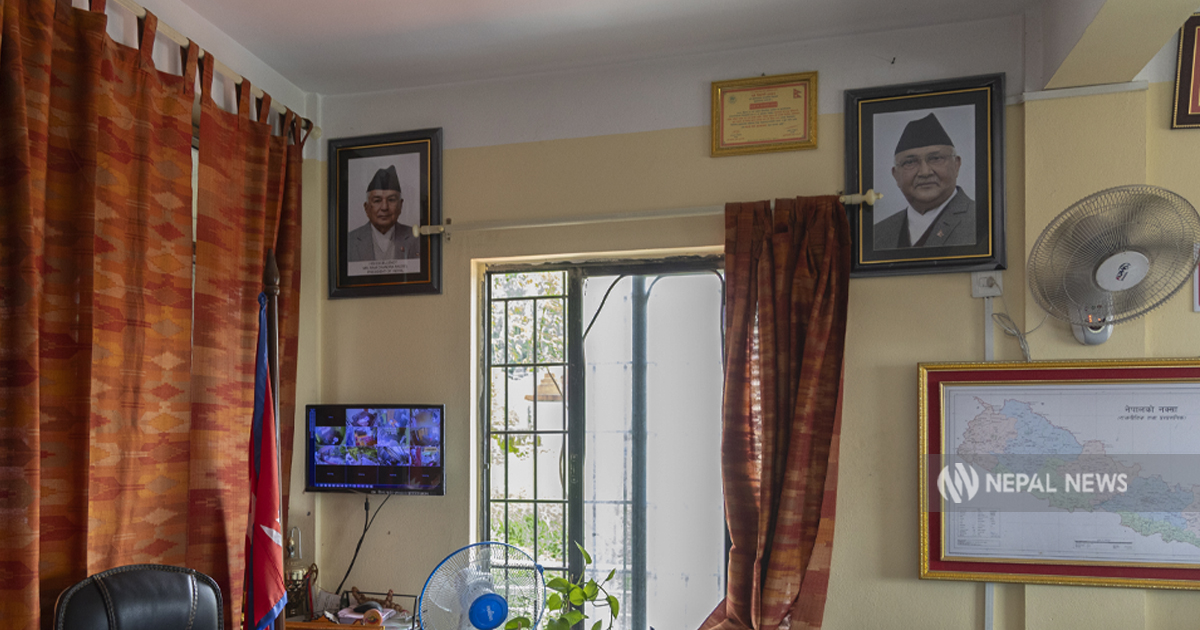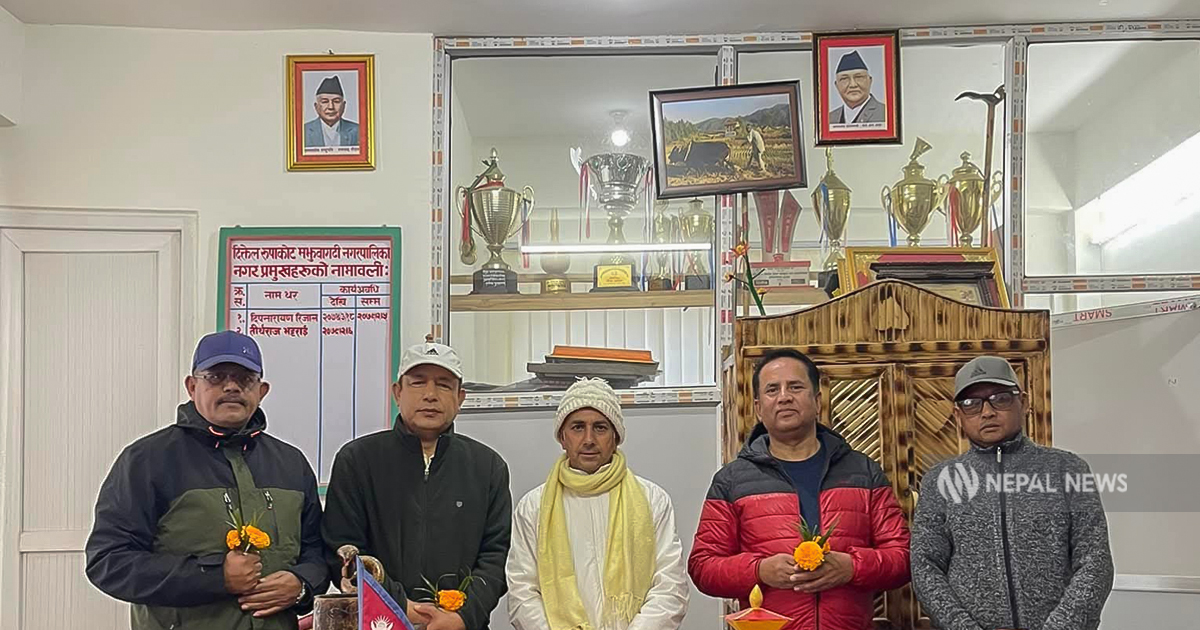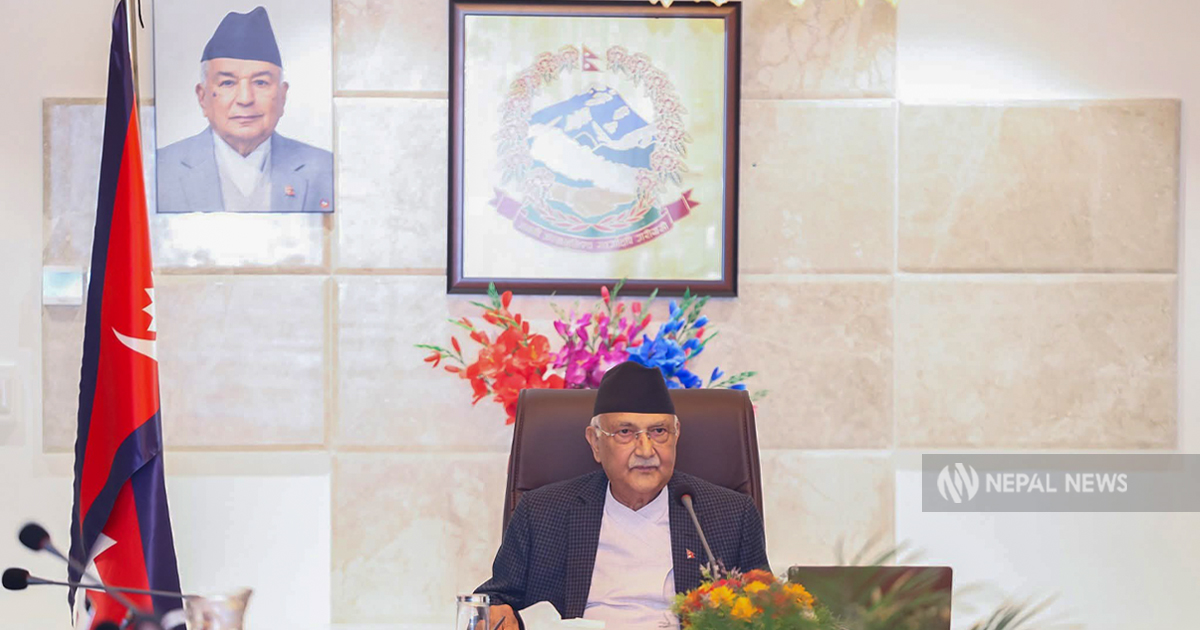
Taxpayers’ money squandered on dignitaries’ portraits

KATHMANDU: After a two-year journey that carried me through some of the world’s most perilous jungles, across multiple countries in Asia, Africa, and South America, and ultimately to Mexico, I felt a rush of excitement upon reaching America. Yet, that joy was fleeting; time and fate seemed to conspire against me.”
In the office of the Ward Chair of Mechinagar Municipality Ward No. 4 in Jhapa, photos of President Ram Chandra Paudel and Prime Minister KP Sharma Oli hang on the wall, purchased by the ward office at a cost of Rs 1,000 each. “When the Prime Minister and President change, the photos must be changed,” Ward Chair Arjun Kumar Karki says. “The price depends on the size and quality of the photo, and we spend according to our financial capacity.”
This custom is not uniform. In the office of Dharan Sub-Metropolitan City Ward No. 17, a photo of Koshi Province Chief Minister Hikmat Kumar Karki is displayed alongside the President and Prime Minister. Ward Chair Surya Bahadur (Manoj) Bhattarai says the Chief Minister’s photo was placed to honor the provincial government, with the cost of a single photo ranging from Rs 1,000 to Rs 1,500, covered by the ward’s budget.
Similarly, in the office of Dolpo Buddha Rural Municipality Ward No. 2 in Karnali Province, photos of the President and Prime Minister are also displayed. According to Ward Chair Bishnu Prasad Bohora, the administrative office of the rural municipality itself distributes photos to the ward offices as soon as the President and Prime Minister change.
On the other hand, in Dodhara Chandani Municipality Ward No. 5 in Sudurpaschim Province, Ward Chair Keshav Bahadur Khatri has placed large photos of Lord Vishnu and Prithvi Narayan Shah instead of the President or Prime Minister, at a cost of about five thousand rupees each. Khatri, who donates his salary to the poor and sick, paid for the photos himself. He is now preparing to add photos of martyrs, including Balbhadra Kunwar, Dasharath Chand Thakuri, and Gangalal Shrestha.
There is no uniformity regarding which photos are displayed in government offices. In ward offices of municipalities of the same level, some have photos of the President and Prime Minister, some of the Chief Minister, some of Lord Vishnu, and some of King Prithvi Narayan Shah.
The practice of hanging photos on the walls of government offices is nationwide. In almost all three tiers of government, constitutional bodies, various commissions, projects, and government departments, photos of the sitting President and Prime Minister are commonly displayed. In some places, the photos of the Chief Minister and the Provincial Head are also hung.
Even in Nepal Police and Armed Police Force offices, alongside the President and Prime Minister, photos of the Inspector General of Police (IGP), Assistant Inspector General (AIG), and Deputy Inspector General (DIG) are displayed. In Nepal Army offices, photos of the Chief of Army Staff (CoAS) are added, while in courts, the tradition is to display the photo of the Chief Justice.
There is no legal or policy provision for displaying photos of the President, Prime Minister, or Chief Minister in government offices. This may be why office heads display photos as they wish. Some independently elected public representatives at the local level hang photos of their favorite personalities instead of the President or Prime Minister.
Local representatives elected from the Rastriya Prajatantra Party (RPP) are seen displaying photos of Prithvi Narayan Shah. Nepali Congress representatives have put up photos of BP Koirala along with the President and Prime Minister, while there are also instances where representatives from communist parties like CPN (Maoist Center) have hung photos of Pushpa Kamal Dahal ‘Prachanda’ or other leftist leaders.

In Dharan Sub-Metropolitan City, representatives of political party affiliates are bringing pictures to hang in the mayor’s office.
The practice has led to several high-profile controversies. In the 2019 by-election, Tilak Rai of the Nepali Congress, who was elected mayor of Dharan Sub-Metropolitan City, placed a photo of BP Koirala in his office alongside the President and Prime Minister. Later, in 2023, independent mayor Harka Sampang removed the photos of the President, Prime Minister, and BP Koirala from his office and hung a photo of Kirat King Yalambar. This caused a huge controversy in Dharan.
The situation escalated when then-Prime Minister Pushpa Kamal Dahal ‘Prachanda’ did not attend a ‘Dharan Founding Day’ event. In a fit of rage, Mayor Rai had the Prime Minister’s photo removed from his office. As the photo controversy grew, youth organizations of political parties entered the sub-metropolitan city office on January 2, 2024, carrying photos of the President and Prime Minister, forcing the government to deploy security personnel to calm the situation.
Other public officials have also made personal statements through their choice of photos. Kathmandu Metropolitan City’s Mayor Balendra Shah has displayed a photo of Greater Nepal in his office, and Damak Municipality Mayor Ram Thapa of Jhapa also has a photo of Prithvi Narayan Shah. Former Koshi Province Health Minister Jayaram Yadav had removed photos of then-President Bidya Devi Bhandari and then-Prime Minister Sher Bahadur Deuba from his office and placed photos of Province Head Parshuram Khapung and then-Chief Minister Rajendra Rai.
Some local units and ward offices are exceptions and do not display anyone’s photo. According to Sabita Rai, Deputy Chairperson of the Thulung Dudhkoshi Rural Municipality in Solukhumbu, no photos were placed in the rural municipality’s office or its wards. “There is no legal provision that says photos must be displayed. No one’s photo was displayed here before, and none are now,” she says.
There is no uniformity regarding which photos are displayed in government offices. In ward offices of municipalities of the same level, some have photos of the President and Prime Minister, some of the Chief Minister, some of Lord Vishnu, and some of King Prithvi Narayan Shah.
In Dodhara Chandani Municipality–10 of Sudurpaschim Province as well, no photographs—whether of the President or the Prime Minister—are displayed. Ward chairperson Chandra Bahadur Singh explained, “If someone sends them as a courtesy, we put them up. Since there is no budget, no photos have been placed.”
The practice of displaying photos of the powerful in government offices is not new. It was a custom since the Rana period and continued during the Panchayat era. On May 27, 1959, then-Prime Minister BP Koirala became the first to replace the portraits of the King and Queen in the Planning Commission Office with a photograph of a poor farmer living in a hut. BP’s understanding was that these poor farmers should be given special attention in Nepal’s development plans. But that lasted only for a short time. After King Mahendra ‘overthrew’ the democratic government in 1960, the custom of hanging photos of the King and Queen in all government offices continued. After the political change in 1990, photos of the Prime Minister also began to be displayed in government offices alongside the King and Queen.
After the People’s Movement of 2006, the government decided to remove the pictures of the king and other royals from all government offices. Former COAS General Rookmangud Katawal wrote in his autobiography, “Suddenly one day, a letter from the Council of Ministers came saying to remove the photos of the King and royals from government offices. I read it and tore it up. The army decided not to remove the photos of Prithvi Narayan Shah from any of its offices.” Although the army did not remove them, the King’s photos were removed from other government offices.
The monarchy ended, and the country entered a republic. Unfortunately, a practice rooted in the Rana era—displaying photos of the powerful to curry favor—has become even more widespread in the republic. Political parties, imitating the monarchy, began to remove the king’s photos and replace them with those of the president and prime minister.
In 2015, a new constitution was issued, and the country entered a federal system, but the display of photos of the influential in government offices at all three levels spread like a disease. Now, this malpractice has extended to the ward level. Six years ago, Ukrainian President Volodymyr Zelenskyy, at his inauguration ceremony, instructed not to hang his picture in offices across the country.
In Nepal, however, the trend of hanging photos has only increased. Human rights leader Krishna Pahadi, an active participant in the 2006 People’s Movement, gives the example that not only Zelenskyy but also BP Koirala urged leaders to display photos of farmers on their walls instead of their own. “Our leaders, however, imitate the royals and hang their own photos,” Pahadi says. “This is the continuation of a personality cult, a slave mentality, and the practice of sycophancy.”

A view of the photo display inside the Diktel Rupakot Majhuwagadhi Municipality office in Khotang.(Photo courtesy of the Diktel Rupakot Majhuwagadhi Municipality Facebook page)
The financial cost of photos
Nepal has the Office of the President, the Office of the Vice President, the Prime Minister’s Office, the House of Representatives, the National Assembly, and 13 constitutional commissions. In addition, there are 22 ministries and more than 50 departments under them. These ministries and departments have offices spread across provinces, districts, and in some cases even down to the local level. Altogether, about 4,000 offices fall under the federal government.
Among the seven provinces, Koshi has 9 ministries, Madhesh 12, Bagmati 14, Gandaki 9, Lumbini 11, Karnali 8, and Sudurpaschim 10—making a total of 73 ministries. Each province also has the Office of the Provincial Head, the Provincial Assembly Secretariat, the Provincial Public Service Commission, the Provincial Planning Commission, the Provincial Investment Authority, the Office of the Chief Attorney, the Office of the Auditor General, and various research and training centers—around 70 such institutions in total. Altogether, there are about 1,500 offices under the ministries and institutions of the provinces. Almost all of these display photos of the President and Prime Minister.
In addition, many provincial offices also display photos of the Chief Minister, and in some cases even of ministers.
Under the Ministry of Federal Affairs and General Administration, there are 77 District Coordination Committees, 753 local governments, and 6,743 ward offices across the country. Likewise, the Supreme Court, High Courts, their benches, and District Courts make up a total of 105 judicial offices.
The Nepal Police, from its headquarters down to various departments, provincial offices, area police offices, and police posts, has about 2,600 offices. Meanwhile, the Armed Police Force, the Nepal Army, the National Investigation Department, and prisons together add about 1,000 offices.
In all 77 districts of the country, there are offices of police, administration, election, public health, accounting units, division and sub-division forest offices, water resources and irrigation offices, and education development and coordination units. According to the Department of Land Management and Archive, Nepal has 110 Land Revenue Offices and 21 Land Reform and Land Revenue Offices, as well as 144 Survey Offices. These offices too have the practice of displaying such photos.
Likewise, there are offices related to labor, employment, and social security, as well as veterinary, agriculture, roads, and postal services in various districts. According to the Flash Report 2081 (2024/25), the country has 28,000 community schools.

A view of a framed picture hanging inside the Prime Minister’s Office.
Advocate Sunil Nepal, who is also the chairperson of the management committee of Bhagwati Elementary School in Dharan, says that some school offices display photos of the President and Prime Minister, while many others display photos of former principals, national luminaries, or other figures. Even if only 25 percent of public schools hang such portraits, the number of government offices nationwide displaying the President’s and Prime Minister’s photos exceeds 20,000.
Government offices typically hang at least one photo, and some display as many as 10 to 12. Assuming an average of two photos per office, this means that about 40,000 photos are hung nationwide.
According to those who place the photos, the price of a framed photo varies depending on quality, ranging from at least Rs. 500 to as much as Rs. 5,000. In Kathmandu, shops making official portraits said that a photo suitable for display in government offices costs between Rs. 2,000 and Rs. 2,500. Based on this, if we take an average price of Rs. 2,000 per photo, the total cost of 40,000 photos across the country amounts to Rs. 80 million. When the President, Prime Minister, Chief Minister, or IGP changes, the photos are also replaced, further increasing this wasteful expenditure.
Former Acting Auditor General Sukadev Bhattarai Khatri says that although efforts to reduce unnecessary expenditure in government offices have been ongoing for three decades, they have never been implemented. Decisions have been made repeatedly to replace imported items with domestic products or even to use stones instead of paperweights in offices. But, he says, such decisions were never enforced. “There is no legal provision requiring photos to be hung. People display photos arbitrarily, and there is also a practice of presenting bills that are higher than the actual cost of the photos. Either the law should regulate this practice, or else it is waste and irregularity that should be stopped,” he argues.
The money spent on photos is equivalent to the annual budget of a ward office in Kathmandu Metropolitan City. That money could instead be used for development work. For example, in 2012, the National Innovation Center founded by Mahabir Pun was built at a cost of Rs. 80 million for infrastructure—the very same amount that is squandered on official portraits. If such unnecessary spending were saved, another innovation center could be established in the country.
Under the ‘President Educational Reform Program’, the government had allocated Rs. 4.5 million for the construction of a four-room school building. By that measure, the Rs. 80 million wasted on photos could build more than 15 school buildings in the hills or Tarai, or even 10 health post buildings in hill districts. Former Acting Auditor General Khatri concludes, “Instead of indulging in sycophancy by hanging photos, attention should be given to spending on creative and constructive purposes.”